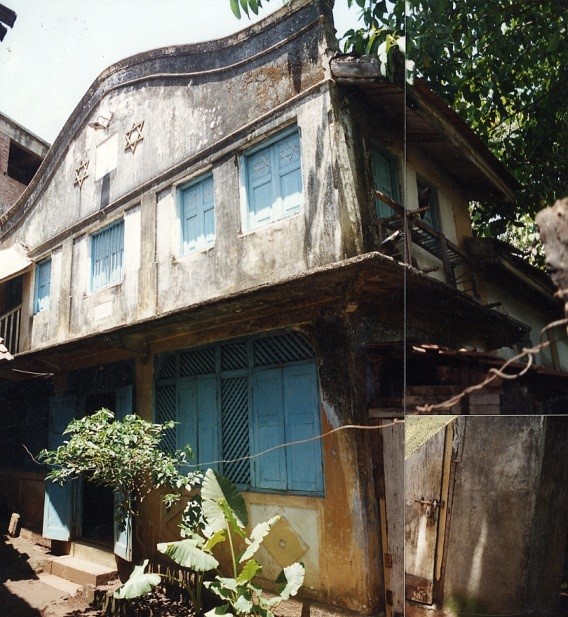SHAAR HATHEPHILAH SYNAGOGUE (1921)
Mhasla
Raigad District, Konkan Region
Maharashtra, INDIA
This Raigad District/Konkan Region synagogue is the farthest from Mumbai. Although still fully intact, it is today no longer regularly functioning since few Jews now live in the area. Nevertheless, some prayer services are held here. There is no regular custodian on staff, so often the building is locked. Guests need to arrange in advance via the Mumbai Bene Israel community to visit the building. Contact this website for possible assistance. To reach this former synagogue and others throughout the sprawling Konkan Region, it is best to hire a car and driver from Mumbai for at least a full day if not two. For an overnight trip, a stay at the comfortable Radisson Hotel on Alibag-Pen Road, Gondhalpada, Varasoli, Alibag, Raigad is suggested.
According to narratives, the Bene Israel Jews were ancient traders from the Middle East who for many years conducted business in India. Eventually they came to settle – perhaps more than two millennia ago – on a permanent basis primarily in a collection of small towns and villages in the Raigad District of the Konkan Region of coastal Maharashtra. They continued to live there for centuries as a mostly isolated disaporic Jewish enclave, following various Jewish customs and lifestyle practices amongst larger native Indian communities. Centuries later, beginning in late 1700s but especially by the mid-1800s, many of the Bene Israel relocated to Mumbai as well as Ahmedabad, Pune, and Karachi Pakistan when these colonial cities were expanding and offering job and lifestyle opportunities. Yet not all Bene Israel Jews chose to leave the Konkan Region. For those that remained, the synagogues that had already been built or the ones realized later continued to remain active religious and communal centers for many more decades.
Beginning in the mid-twentieth century, as a result of political and social change in India, the Bene Israel began to leave India mostly for Israel. At that point, the entire Bene Israel community numbered according to estimates some twenty thousand people. From this pattern of immigration, the Bene Israel population of Bene Israel dropped precipitously to a few thousand, and the number of Jews currently living Konkan Region is quite small. Of the thirteen synagogue buildings built in the assortment of towns and villages in this region from the mid-nineteenth to early twentieth centuries, only eleven physically survive today. Of those, only a few are active houses of prayers, others endure marginally, and the balance has closed and sit empty or converted to others functions.
Shaar Hathephilah (Hebrew for Gate of Prayer) Synagogue, in the village of Mhasla, represents another of the thirteen Bene Israel congregations that were organized in the Raigad District during the mid-to-last nineteenth century. In time, these small congregations erected proper synagogues, and in cases some of these buildings were rebuilt for various reasons into the first quarter of the twentieth century. Shaar Hathephilah was organized in 1886, yet this synagogue was not realized until 1921. Constructed by means of contributions by its membership, the building sits on a mostly unspoiled site surrounded by other small-scaled village buildings.
Shaar Hathphilah’s porch runs along the short end of the building. Altered in more recent years, the ground floor was originally a covered yet open space, but today it is enclosed with wall and window openings. Doors at the porch open into the sanctuary. Within the porch is also a stair to the upper level, with its original design more intact. The upstairs porch is covered and contained only by painted wood balusters. Off this area are the doors opening into the single-ended gallery where the women sat. According to Orthodox synagogue organization, the genders are separated, so Shaar Hathpilah follows this convention. Shaar Hathphilah’s other short elevation (at the west side of the building) features a projecting apse containing the heckal, or ark.
The rectangular sanctuary follows the planning of other Bene Israel synagogues with its centrally-positioned raised tebah (bimah, or an area containing a reader’s platform from where the service is led) and to the far wall the heckal (ark). The tebah is constructed out of wood that has been painted. Its design includes raised panels at its base, turned newel posts and balusters, and a shaped handrail. Projecting from the corners of the tebah are decorative brass fixtures and rods. Placed in the center of the western elevation that is closest to Jerusalem as per synagogue convention, the heckal is a wooden cabinet that is draped in the traditional cloth called the parachot. The heckal, as per synagogue tradition, is raised off the floor by a few steps. The face of the heckal wall is decorated by an arched lintel supported by matching pilasters with Corinthian-like capitals. This element was not original to the building.
Beth El sanctuary’s, which has been altered over the years in response to fundraising and beautification efforts, features include light gray marble floor pavers that also run along the lower walls as a wainscot, the white chunam walls, wall sconces, framed Jewish art displayed around the room, and large painted wood casement windows, transoms with stained glass, and clerestories casement units. Added some years back were fixed metal grilles at the windows. The trim surrounding the windows is intricate as are the panels below some of the windows with their cusped design that was influenced by some traditional Indian architecture. Hanging from the flat ceiling with its applied trim and Magen David (Star of David) in the center are a variety of ceiling fans, glass lanterns, and lighting fixtures. Other architectural and liturgical design features include the freestanding wooden benches along the perimeter of the sanctuary and the matching pair of draped chairs adjacent to the heckal. One is for the Elijah, and the other used for the circumcision ceremony.
In 2011, for its quasquicentennial anniversary since the founding of the congregation, the membership of Shaar Hathephilah held a celebration at the synagogue.

Exterior

Interior








